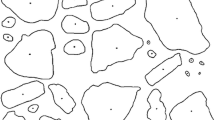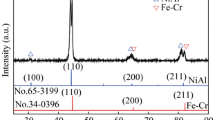Abstract
In previous investigations on wear mechanisms at high temperatures made in High Temperature-Single Impact Test (HT-SIT) and High Temperature-Continuous Impact Abrasion Test (HT-CIAT), predominant wear mechanisms were identified and correlations to different material parameters could be presumed. In order to confirm these correlations, four different alloys which are promising to be used in high temperature applications like a sinter grate have been studied in the High Temperature-Erosion Test (HT-ET) by the use of different impact angles and different impact energies. Especially the change of wear mechanism caused by increasing testing temperature was analysed in detail. Characterisation of microstructure and wear behaviour has been done by optical microscopy (OM) and scanning electron microscopy (SEM). Results obtained by the use of the different measurement techniques were linked and set into comparison to calculate the volumetric wear of the specimen. Predominant wear mechanisms were determined using OM in the mode of cross-section images and SEM. The results indicate that material parameters such as hardness and hard phase content can be correlated to the erosion wear rates at different impact angles. The test results indicate that at higher temperatures, the material fatigue becomes a major wear-determining factor. The test results also confirmed that there is a critical impact energy for each material above where the wear rate increases significantly. Test results with thermally aged materials also show that a better heat-resistant matrix reduces the material fatigue thus resulting in lower wear rates.












Similar content being viewed by others
References
Winkelmann, H., Badisch, E., Kirchgassner, M., Danninger, H.: Wear mechanisms at high temperatures—part1: wear mechanisms of different Fe-based alloys at elevated temperatures. Tribol. Lett. doi:10.1007/s11249-009-9421-y
Speich, G.R.: Physical metallurgy of dual-phase steels. In: Fundamentals of dual-phase steels. pp. 1–45. The Metallurgical Society, (1981)
Nakota, K., Araki, K., Kurihara, K.: Formable HSLA and dual phase steels. TMS-AIME. p. 183 (1979)
Davies, R.G., Magee, C.L.: Structure and properties of dual phase steels. p. 1, TMS-AIME, New York (1979)
Rashid, M.S.: An unique high strength sheet steel with superior formability. Preprint 760206. Society of Automotive Engineers (1976)
Davenport, A.T. (ed.): Formable HSLA and Dual Phase Steels. American Institute of Mining, Metallurgical, and Petroleum Engineers, Littleton (1977)
Prasad, B.K., Prasad, S.V.: Abrasion-induced microstructural changes during low stress abrasion of a plain carbon (0.5% C) steel. Wear 151, 1–12 (1991). doi:10.1016/0043-1648(91)90341-Q
Larsen-Badse, J., Mathew, K.G.: Influence of structure on the abrasion resistance of a 1040 steel. Wear 14, 199–205 (1969). doi:10.1016/0043-1648(69)90041-6
Moore, M.A.: The relationship between the abrasive wear resistance, hardness and microstructure of ferritic materials. Wear 28, 59–68 (1974). doi:10.1016/0043-1648(74)90101-X
Hurricks, P.L.: Some metallurgical factors controlling the adhesive and abrasive wear resistance of steels. A review. Wear 26, 285–304 (1973). doi:10.1016/0043-1648(73)90184-1
Modi, O.P., Prasad, B.K., Jha, A.K., Das, S., Yegneswaran, A.H.: Abrasive wear behaviour of an AISI 5132 steel under low stresses. Mater. Trans. JIM 35, 67–73 (1994)
Modi, A.P.: Effect of microstructure and experimental parameters on high stress abrasive wear behaviour of a 0.19% wt C dual phase steel. Tribol. Int. 40, 490–497 (2006). doi:10.1016/j.triboint.2006.04.013
Allen, C., Ball, A.: A review of the performance of engineering materials under prevanlent tribilogcal and wear. Tribol. Int. 29(2), 105–116 (1996). doi:10.1016/0301-679X(95)00073-D
Kirchgaßner, M., Badisch, E., Franek, F.: Behaviour of iron-based hardfacing alloys under abrasion and impact. Wear 265, 772–779 (2008). doi:10.1016/j.wear.2008.01.004
Badisch, E., Mitterer, C.: Abrasive wear of high speed steels: influence of abrasive particles and primary carbides on wear resistance. Tribol. Int. 36, 765–770 (2003). doi:10.1016/S0301-679X(03)00058-6
Francucci, G., Sikora, J., Dommarco, R.: Abrasion resistance of ductile iron austempered by the two step process. Mater. Sci. Eng. A 485, 46–54 (2008). doi:10.1016/j.msea.2007.07.081
Kassim, S.R.: Equivalent hardness concept and two-body abrasion of iron-base alloys. Wear 243, 92–100 (2000). doi:10.1016/S0043-1648(00)00425-7
Bressan, J.D., Baros, D.P., Sokolwski, A., Mesquita, R.A., Barbosa, C.A.: Influence of hardness on the wear resistanc of 17–4 PH stainless steel evaluated by the pin-on-disc testing. J. Mater. Process. Technol. 205, 353–359 (2008). doi:10.1016/j.jmatprotec.2007.11.251
Celik, O., Ahlatci, H., Kayali, E.S., Cimenoglu, H.: High temperature abrasive wear behavior of an as-cast ductile iron. Wear 258, 189–193 (2005). doi:10.1016/j.wear.2004.09.004
Straffelini, G., Trabucco, D., Molinari, A.: Oxidative wear of heat-treated steels. Wear 250, 485–491 (2001). doi:10.1016/S0043-1648(01)00661-5
Chatterjee, S., Pal, T.K.: Wear behaviour of hardfacing deposits on cast iron. Wear 255, 417–425 (2003). doi:10.1016/S0043-1648(03)00101-7
Powell, G.L.F., Carlson, R.A., Randle, V.: The morphology and microtexture of M7C3 carbides in Fe–Cr–C and Fe–Cr–C–Si alloys of near eutectic composition. J. Mater. Sci. 29, 4889–4896 (1994). doi:10.1007/BF00356539
Leško, A., Navera, E.: Microstructural characterisation of high-carbon ferrochromium. Mater. Charact. 36, 349–356 (1996). doi:10.1016/S1044-5803(96)00068-X
Atamert, S., Bhadeshia, H.K.D.H.: Microstructure and stability of Fe–Cr–C hardfacing alloys. Mater. Sci. Eng. A 130, 101–201 (1990). doi:10.1016/0921-5093(90)90085-H
Fischer, A.: Hartlegierungen auf Fe–Cr–C–B Basis für die Auftragschweißung, Fortschrittberichte der VDI Zeitschriften, p. 69. VDI Verlag GmbH, Düsseldorf (1984)
Buytoz, S.: Microstructural properties of M7C3 eutectic carbides in Fe–Cr–C alloy. Mater. Lett. 60, 605–608 (2006). doi:10.1016/j.matlet.2005.09.046
Katsich, C., Badisch, E., Roy, M., Heath, G.R., Franek, F.: erosive wear of hardfaced Fe–Cr–C alloys at elevated temperature. Wear (accepted for publication)
Moore, D. “4”. Basic Practice of Statistics (4 edn.). WH Freeman Company. pp. 90–114. ISBN 0-7167-7463-1. (August 2006)
Acknowledgements
This study was funded by the “Austrian Kplus-Program” and has been carried out within the “Austrian Center of Competence for Tribology”. The authors are also grateful to Böhler-Edelstahl for providing steels and performing heat-treatment procedures for different steel types, and Castolin Eutectic for help in the manufacturing of the welding samples. Katsich Christian is acknowledged for help in performing tests and wear quantification.
Author information
Authors and Affiliations
Corresponding author
Rights and permissions
About this article
Cite this article
Winkelmann, H., Varga, M., Badisch, E. et al. Wear Mechanisms at High Temperatures: Part 2: Temperature Effect on Wear Mechanisms in the Erosion Test. Tribol Lett 34, 167–175 (2009). https://doi.org/10.1007/s11249-009-9425-7
Received:
Accepted:
Published:
Issue Date:
DOI: https://doi.org/10.1007/s11249-009-9425-7




